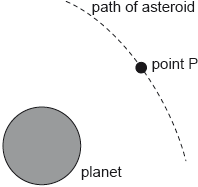| Date | May 2022 | Marks available | 3 | Reference code | 22M.2.HL.TZ2.7 |
| Level | Higher level | Paper | Paper 2 | Time zone | 2 |
| Command term | Determine | Question number | 7 | Adapted from | N/A |
Question
A metal sphere is charged positively and placed far away from other charged objects. The electric potential at a point on the surface of the sphere is 53.9 kV.
A small positively charged object moves towards the centre of the metal sphere. When the object is 2.8 m from the centre of the sphere, its speed is 3.1 m s−1. The mass of the object is 0.14 g and its charge is 2.4 × 10−8 C.
Outline what is meant by electric potential at a point.
The electric potential at a point a distance 2.8 m from the centre of the sphere is 7.71 kV. Determine the radius of the sphere.
Comment on the angle at which the object meets equipotential surfaces around the sphere.
Show that the kinetic energy of the object is about 0.7 mJ.
Determine whether the object will reach the surface of the sphere.
Markscheme
the work done per unit charge ✓
In bringing a small/point/positive/test «charge» from infinity to the point ✓
Allow use of energy per unit charge for MP1
use of Vr = constant ✓
0.40 m ✓
Allow [1] max if r + 2.8 used to get 0.47 m.
Allow [2] marks if they calculate Q at one potential and use it to get the distance at the other potential.
90° / perpendicular ✓
OR 0.67 «mJ» seen ✓
«p.d. between point and sphere surface = » (53.9 kV – 7.71) «kV» OR 46.2 «kV» seen ✓
«energy required =» VQ « = 46 200 × 2.4 × 10-8» = 1.11 mJ ✓
this is greater than kinetic energy so will not reach sphere ✓
MP3 is for a conclusion consistent with the calculations shown.
Allow ECF from MP1
Examiners report
a) Well answered.
b) Generally, well answered, but there were quite a few using r + 2.8.
ci) Very few had problems to recognize the perpendicular angle
cii) Good simple calculation
ciii) Many had a good go at this, but a significant number tried to answer it based on forces.


